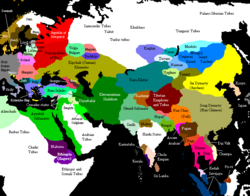- Merkit people
-
- Distinguish from meerkat (the animal, and other uses).
Mergid
Three Mergids
Мэргид ханлигnomadic confederacy ← 
←
11th century–1200  →
→Mergid and their neighbours at 1180s. Capital Not specified Language(s) Middle Mongolian Religion Tengriism (Shamanism) Government Elective monarchy Togtoa (2nd) Legislature Khurultai Historical era Medieval Ages - Established 11th century - Disestablished 1200 Today part of  Mongolia
Mongolia
 Russia(Buryatia)
Russia(Buryatia)The Mergid (also known Merkit, Cyrillic: Мэргид, lit. "skillful ones") was one of the five major tribal confederations (khanlig) in Mongolian plateau in the 12th century.
The Mergids inhabited in basins of the Selenge River and lower Orkhon River. After a long struggle over two decades, they were defeated in 1200 and incorporated into the Mongol Empire formed by Genghis Khan.
Contents
Three Mergids
The Mergids was confederation of the three tribes, inhabited in basin Selenge River and Orkhon River.
- Uduyid Mergids lived in place named as Buur-kheer, near lower Orkhon River;
- Uvas Mergids lived in place named as Tar, between Orkhon River-Selenge River;
- Khaad Mergids lived in place named as Kharaji-kheer, in Selenge River.
Ethnic relations
The ethnicity of the Mergids is somewhat obscure; its likely that they were Turkic or Mongolic (related to Mongols, Naimans, Keraits, and Khitan), but it has also been postulated that they are more closely related to Paleosiberian,[citation needed] such as the Chukchi, or to Tungusic peoples, such as the Manchu and the Evenks.[citation needed]
Conflict with Genghis Khan
Temüjin's mother Hoelun, originally from the Olkhunut tribe, had been engaged to the a Mergid chief Yehe Chiledu by 1153. She was abducted by Temüjin's father Yesugei, while being escorted home by Yehe Chiledu.
In turn, Temüjin's new wife Börte was kidnapped by Mergids raiders from their campsite by the Onon river around 1181 and given to one of their warriors. Temüjin, supported by his blood brother Jamukha and his foster-father Toghril, the Khan of the Khereit, attacked the Mergid and rescued Börte within the year. The Mergids were dispersed after this attack. Shortly thereafter she gave birth to a son named Jochi. Temüjin accepted paternity but the question kept lingering throughout Jochi's life. Those incidents resulted in a strong animosity between Temüjin and his family and the Merkits. Over the following two decades, he attacked them several times.
By the time he had united the other Mongol tribes and was given the title "Genghis Khan" in 1206, the Merkits seem to have disappeared as a separate ethnic group. Those who survived were most likely absorbed by other Mongol tribes, such as the Oirats and others who fled to Kypchaks mixed with them. In 1215-1218, Jochi and Subotai crushed the remnants of them under their former leader Toghta Bekis' family. The Mongols clashed with the Kankalis or the Kypchaks because they gave shelter to them. Genghis Khan had Mergid Khatun named Khulan. Genghis and his son Khulgen died while Mongol forces laid siege to a Russian settlement in Ryazan in 1236. During the Mongol invasion of Volga Bulgaria, a body of the Merkid was found in the Bulgar-Kypchak dominated areas in 1236.
Late Mergids
Few Mergids achieved prominent position among the Mongols. But they were classified as the Mongols in Mongolian Society. Great Khan Guyuk's beloved khatun Oghul Qaimish, who was a regent from 1248-1251, was a Mergid woman. And traditionalist Bayan and his cousin Toghta served as Grand councilors of the Yuan Dynasty in China and Mongolia. After the fall of the Yuan Dynasty, they were a clan of a banner in Northern Yuan.
References
Categories:- Former countries in Central Asia
- States and territories established in the 11th century
- Eurasian nomads
- Mongol peoples
- Samoyedic peoples
- History of the Turkic people
Wikimedia Foundation. 2010.

